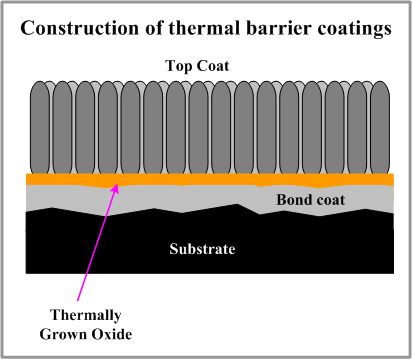What is the full form of TBCTBC: Thermal Barrier CoatingsTBC Stands for Thermal Barrier Coatings. The protection of metallic parts used in both airborne and stationary gas turbines is frequently provided by thermal barrier coatings (TBCs). A combustion chamber, blades, and vanes are among the parts of the hot section. The TBC significantly reduces the amount of heat that is transferred from the metal surface to the high-temperature gas. As a result, the efficiency of the gas turbines would be significantly increased with an increase in operating temperature. A bond coat and a top coat make up a TBC system's typical multilayer additional structure. 
In contrast to the bond coat, which can also serve as oxidation resistance, the top coat is thermally resistant. The function of thermal insulation and the durability against spallation during thermal service serve as two essential performances that direct the selection of materials, the customization of the structural design, as well as the process optimization of TBC. The ceramic top coat of the TBCs plays a significant role in these two performances. Because of this, the top coat's composition and structure are crucial for the creation of advanced TBCs. TBCs are now employed in the majority of industrial applications; nevertheless, they are not fully designed integrated elements of the gas turbines, so the gas turbine can survive a total spallation of the TBCs without suffering a catastrophic failure until the next downtime. This means that the design does not utilize TBCs to their fullest extent. To solve this issue, two different approaches are currently used. To get more accurate forecasts, one approach is to further improve lifetime modeling. The next section will go through this in more detail. Another option is to employ monitoring equipment to ascertain the TBCs' remaining lifespan directly inside the gas turbine. History Of Thermal Barrier Coatings (TBC)For at least 20 years, there has been an intense effort in the domain of lifetime prediction of TBCs. There were a lot of studies done, particularly inside NASA, which resulted in a strain-controlled model with a sizable number of parameters. The intricacy of the TBCs and their failure processes contribute to the challenges in precise lifespan prediction. Furthermore, a lot of variability in lifetime data is caused by the coating procedures' generally low reproducibility. The models that have been created for both systems have been constructed differently to reflect the disparate microstructures of APS and EB-PVD TBCs. Most of the time, other failure mechanisms like erosion, foreign object damage (FOD), or corrosion are not taken into account when calculating lifetime estimates for gas turbines, despite the fact that they could have a significant impact on performance depending on the fuel being used or the operating environment. Role Of Thermal Barrier Coatings (TBC)The bond between the metallic covering and the ceramic in TBCs made of air plasma-sprayed zirconia is thought to be "mechanical." The initial splats' interaction with the topological characteristics of the bond coat surface helps to establish the bond early in the deposition process. The bond coat has been inserted into the ceramic in a peninsular fashion for many of the surface elements. In order to manage the TBC system's durability, the bond coat's surface roughness is extremely important. Characteristics Of Thermal Barrier Coatings (TBC)
Next TopicFull Form
|
 For Videos Join Our Youtube Channel: Join Now
For Videos Join Our Youtube Channel: Join Now
Feedback
- Send your Feedback to [email protected]
Help Others, Please Share










